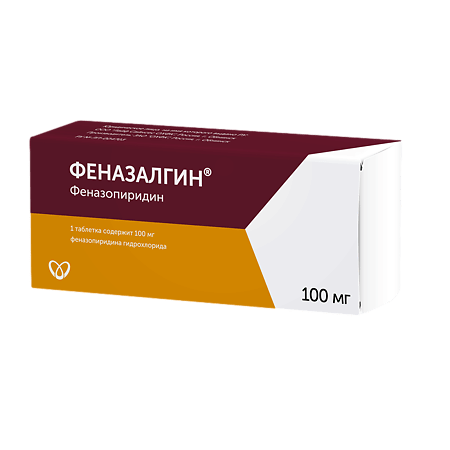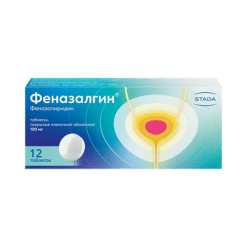No products in the cart.
Phenazalgin, tablets 100 mg 10 pcs
€1.00
Out of stock
(E-mail when Stock is available)
Description
Phenazopyridine, excreted with urine, affects the mucous membrane of the lower urinary tract, where it has a local analgesic effect.
This effect helps to reduce dysuric phenomena including pain, burning and frequent urination.
The exact mechanism of action is unknown.
Indications
Indications
Active ingredient
Active ingredient
Composition
Composition
Brown film-coated tablets, round, biconvex;
The cross section shows a brown core with white flecks, turning red in the air.
Associates:
Sodium carboxymethyl starch – 26 mg,
Microcrystalline cellulose – 115.5 mg,
Colloidal silica – 2.5 mg,
Talc – 3.75 mg,
Magnesium stearate – 2.25 mg.
Shell composition:
Hypromellose 6 – 3.9 mg,
Talc – 1.288 mg,
Polydextrose – 1.5 mg,
Titanium dioxide – 1.3 mg,
Macrogol 3350 – 0.6 mg,
Iron oxide dye black – 0.279 mg,
Iron oxide dye yellow – 0.763 mg,
Iron oxide dye red – 0.37 mg.
Interaction
Interaction
Concomitant administration may increase bioavailability of ciprofloxacin.
There are no data on other drug interactions.
Phenazopyridine may be administered together with antimicrobial agents if necessary.
Directions for use
Directions for use
Overly, whole, after meals, with a full glass of water, do not chew the tablets.
Adults: 2 tablets (200 mg) 3 times a day.
The duration of treatment is not more than 2 days (also in combination with antimicrobials).
The efficacy and safety of phenazopyridine in children under 18 and people older than 65 years of age is not established.
If the patient accidentally misses a dose of phenazopyridine, it should be taken as soon as possible; if the patient remembers the missed dose of the drug in the period immediately before taking the next dose, it should not be doubled.
Special Instructions
Special Instructions
The use of phenazopyridine to relieve symptoms of dysuria due to infection should not delay diagnosis and initiation of pathogenetic therapy.
The drug should be used for symptomatic pain relief and not to replace specific antimicrobial therapy.
In patients with glucose-6-phosphate dehydrogenase deficiency, administration of phenazopyridine may lead to erythrocyte hemolysis and methemoglobinemia.
Phenazopyridine use may cause dark orange or reddish staining of urine (with an alkaline reaction) and orange-red staining of feces.
A yellowish coloring of the skin or sclerae may indicate accumulation of phenazopyridine as a result of renal dysfunction or overdose or taking the drug for more than 2 days, which requires stopping the drug.
Wearing contact lenses should be avoided because phenazopyridine may cause staining of contact lenses.
The duration of treatment with phenazopyridine should not exceed 2 days.
2,3,6-triaminopyridine (one of the metabolites of phenazopyridine) has demonstrated the ability to damage transverse striated muscle cells and cardiomyocytes in toxicology studies.
We recommend caution when using phenazopyridine in patients with heart disease and neuromuscular disease.
Phenazopyridine is contraindicated in patients with any liver disease.
Phenazopyridine is contraindicated in patients with renal failure. The possibility of age-related reduction in renal function should be borne in mind. There are no data on the use of phenazopyridine in patients older than 65 years, including those with impaired renal function.
Phenazopyridine may cause changes in the results of urine tests by colorimetric, photometric and fluorimetric methods (determination of ketone bodies, porphyrins, urobilinogen).
In case of adverse reactions, the patient should stop using the drug and see a physician immediately.
The effect on driving and operating ability
The potential development of such side effect as dizziness must be taken into account.
If dizziness occurs, refrain from performing the above activities.
Features
Features
The pharmacokinetic properties of phenazopyridine have not been fully studied.
Phenazopyridine and its metabolites are rapidly eliminated from the body by the kidneys.
The absorption of phenazopyridine was 90% within 24 hours of taking 600 mg per day, with 41% as an unchanged drug and 49% as a metabolite.
Contraindications
Contraindications
With caution
Side effects
Side effects
According to the classification of the World Health Organization (WHO), adverse reactions are presented according to their frequency of occurrence:
Very common (â¥1/10); common (â¥1/100, <1/10), infrequent (â¥1/1000, <1/100), rare (â¥1/10 000, <1/1000) and very rare (<1/10 000), frequency unknown – the incidence could not be determined from available data.
Central nervous system: rarely – headache, dizziness, aseptic meningitis.
Gastrointestinal and hepatic disorders: rarely – nausea, vomiting, diarrhea; very rarely – acute hepatotoxicity (associated with overdose of the drug), jaundice.
Renal and urinary tract disorders: uronephrolithiasis, acute nephrotoxicity (associated with drug overdose).
The immune system: rare – skin rash, itching, fever and other hypersensitivity reactions; very rare – bronchospasm.
Allergic reactions: anaphylactoid reaction, allergic hepatitis.
Blood and lymphatic system disorders: methemoglobinemia, hemolytic anemia (with glucose-6-phosphate dehydrogenase deficiency), sulfohemoglobinemia, neutropenia, leukopenia, pancytopenia.
Other disorders: rare – staining of stools orange-red, staining of urine dark orange or reddish;
very rare with long-term use – change in pigmentation of the skin and sclerae with yellowish coloring, swelling of the face, upper and lower extremities; yellowing of nails, visual disturbances, eye irritation, pain in the ears, reversible loss of color vision.
Overdose
Overdose
Exceeding the recommended dose of phenazopyridine (especially in patients with reduced renal function and in elderly patients) may lead to an increase in its serum concentration and development of toxic reactions.
Symptoms: methemoglobinemia (especially in patients with glucose-6-phosphate dehydrogenase deficiency), nephro- and hepatoxic manifestations, as well as increased expression of other side effects of the drug.
Treatment: discontinue the drug, induce vomiting and other measures aimed at eliminating phenazopyridine from the body, as well as symptomatic therapy. Intravenous administration of 1% methylene blue solution (1-2 mg/kg) is advisable to eliminate methemoglobinemia and related symptoms.
Additional information
| Shelf life | 5 years. Do not use after the expiration date stated on the package. |
|---|---|
| Conditions of storage | The drug should be kept out of reach of children, protected from light at a temperature not exceeding 30 ° C. |
| Manufacturer | Obninsk HFC, Russia |
| Medication form | pills |
| Brand | Obninsk HFC |
Other forms…
Related products
Buy Phenazalgin, tablets 100 mg 10 pcs with delivery to USA, UK, Europe and over 120 other countries.

















